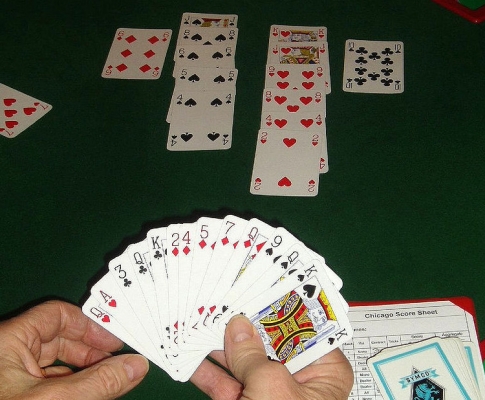The Upper-Cut - Bridge
In boxing terms, upper-cut applies to a swift, strong blow to the underside of the jaw, generally knocking the opponent out. An upper-cut in bridge is the play of a card forcing declarer to use a high card and thereby promoting a card in partner's hand to become a winner. The effect on declarer's hand possibly has the same effect as in the boxing ring – a knockout punch.
Consider the following hand in which you are sitting South. East deals and opens a weak 2♦ . You bid 4♥ and West bids 6, the final contract. You lead the ♥ A which wins, partner following with the ♥7 and declarer the ♥8. How do you proceed?
| Dummy (West) | ||
| ♠ A K Q | ||
| ♥ J 9 | ||
| ♦ 10 6 4 3 | You (South) | |
| ♣ A K Q | ♠ 4 | |
| ♥ A K Q 10 6 5 4 3 | ||
| ♦ Q 9 ♣ 10 9 | ||
Prospects for a second trick are bleak: The black suits offer no chance and you know from a count of the hearts that declarer has no more cards in that suit, so that's a dead end. Your only hope lies with the ♦Q.
From his opening bid, declarer has 6 diamonds, presumably headed by the A K and with dummy's 4 cards making 10 cards in that suit, he is unlikely to play for a finesse. Time to use your imagination. Your partner is now also void in hearts and has a single trump. What if that trump is the ♦J? If you can induce him to use it to trump a heart, declarer will be forced to over trump with either the ♦A or ♦K, promoting your ♦Q for the setting trick – a killing upper-cut. A word of caution, though: If you lead the ♥ K at trick 2, partner may simply discard a club or spade, so you should rather play a small heart, creating the illusion that declarer has the ♥ K. Partner will certainly ruff what he believes to be the opponents' winner. Declarer will, of course over ruff with his ♦K and bang down the ♦A, hoping to drop the ¨Q. When the lady fails to oblige, he must concede the contract, one down. The full hand:
| North | ||
| ♠ 10 7 6 5 3 2 | ||
| ♥ 7 | ||
| West | ♦ J | East |
| ♠ A K Q | ♣ J 7 6 5 4 | ♠ J 9 8 |
| ♥ J 9 2 | ♥ 8 | |
| ♦ 10 6 4 3 | South | ♦ A K 8 7 5 2 |
| ♣ A K Q | ♠ 4 | ♣ 8 3 2 |
| ♥ A K Q 10 6 5 4 3 | ||
| ♦ Q 9 ♣ 10 9 |
Here is another hand requiring thoughtful defense. This time you are sitting West. North opens with 2 ♠, partner bids 3 ♥ and South 4 ♠, which is passed all round. Partner wins the first two tricks with the ♥ A and ♥ K, you echoing with the ♥ 9 and ♥ 4 and declarer following with the ♥ 2 and ♥ 5. Partner continues with the ♥ Q. With your seemingly worthless hand, you face the following position:
| You (West) | |
| ♠Q | |
| ♥ - | |
| ♦ J 10 9 6 5 | Dummy |
| ♣ J 10 6 4 2 | ♠4 3 |
| ♥ 10 8 | |
| ♦ A K 4 ♣ A Q 9 7 |
From the bidding, you know declarer has 6 spades and therefore partner has 4. If his spades are as good as ♠K 8 x x or even ♠J 9 x x, your spade lady may prove to be worth her weight in gold. Instead of uselessly discarding a minor suit card on partner's ♥ Q, trump it with your ♠Q, hopefully delivering the fatal upper-cut to the opponents' game contract.
Here is the full hand:
| North | ||
| ♠ A J 10 9 6 2 | ||
| ♥ 5 2 | ||
| West | ♦ Q 3 2 | East |
| ♠ Q | ♣ 5 3 | ♠K 8 7 5- |
| ♥ 9 4 | ♥ A K Q J 3 | |
| ♦ J 10 9 6 5 | South | ♦ 8 7 |
| ♣ J 10 6 4 2 | ♠ 4 3 | ♣ K 8 |
| ♥ 10 8 7 6 | ||
| ♦ A K 4 ♣ A Q 9 7 |
You can see how your upper-cut will ensure your side wins 2 spade tricks to defeat the contract. As with all other aspects of the game, defense requires careful thought and not a little imagination. Happy punching!








Comments